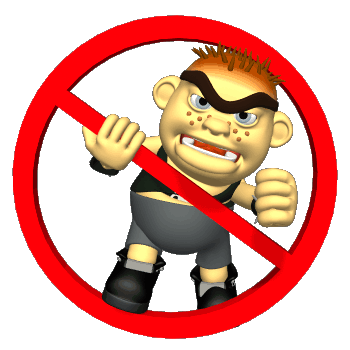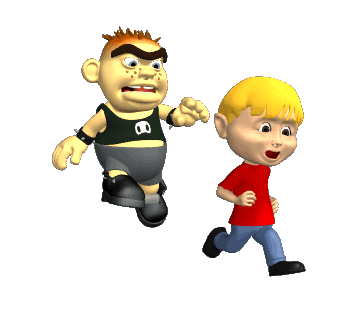Bullying
Are You Being Bullied
Who is it that Gets Bullied?
-
Bullying can happen anywhere, anytime and to ANYONE.
-
-
Bullies come from every walk of life, boys, girls, junior schiil, high school, colledge, in fact ANYONE can be a bully.
-
Bullying is about someone’s behavior toward another person it is repeated verbal, physical, social or psychological aggressive behaviour by a person or group directed towards a less powerful person or group that is intended to cause harm, distress or fear.
-
The one sure thing is that no one EVER deserves to be bullied.
Remember: If you are being bullied, Talk to Someone, Raise it with someone, because it is NOT your fault! it is theirs.
CHILDREN'S RIGHTS
It’s your right as a child not to be bullied by anyone. As a young person under Children’s rights which are unique in in many ways, as they are designed for the safety and protection of children, but have to be provided for by adults and the government.
Although children and young people are covered under the Human Rights Act 1998, their rights are more clearly specified under the UN Convention on the Rights of the Child (UNCRC). Although neither specifically mentions bullying, bullying behaviour does breach a number of the articles in both. Alongside this, both outline the responsibilities of adults to protect and safeguard children and young people from bullying behaviour. Get familiar with these, which will help you to form policies, or even campaighn about the way bullying is treated.
Bullying and the Human Rights Act 1988
The European Convention on Human Rights (ECHR) does not distinguish between children’s rights and adult’s rights. It contains the rights required to be accorded to every human being and respected without discrimination on any grounds.
These are the Convention rights set out in schedule 1 to the Human Rights Act.
Article 2: The right to life
Article 3: Prohibition of torture
Article 4: Prohibition of slavery and forced labour
Article 5: Right to liberty and security
Article 6: Right to a fair trial
Article 7: No punishment without law
Article 8: Right to respect for private and family life
Article 9: Freedom of thought, conscience and religion
Article 10: Freedom of expression
Article 11: Freedom of assembly and association
Article 12: Right to marry
Article 14: Prohibition of discrimination
Article 16: Restrictions on political activity of aliens
Article 17: Prohibition of abuse of rights
Article 18: Limitation on use of restrictions on rights
The First Protocol
Article 1: Protection of property
Article 2: Right to Education
Article 3: Right to free Elections
Bullying is a breach of many of these rights, with those being bullied facing persecution by individuals(s).
This could include:
Article 3
“No one shall be subjected to torture or to inhuman or degrading treatment or punishment.”
Bullying is a form of torture by those who experience it. Failure by schools or other organisations to intervene when they have been notified of any incident may be in breach of article 3.
Article 14
“The enjoyment of the rights and freedom of any ground such as colour, race, sex, language, religion, political or other opinion, national or social origin, association with a national minority birth or other status”
Bullying is often based on discrimination, with individuals being targeted because of who they are or who they are perceived to be. Failure to prevent bullying, due to discrimination, may be in breach of this act.e enjoyment of the rights and freedom of any ground such as colour, race, sex, language, religion, political or other opinion, national or social origin, association with a national minority birth or other status”
Bullying is often based on discrimination, with individuals being targeted because of who they are or who they are perceived to be. Failure to prevent bullying, due to discrimination, may be in breach of this act.
Article 2, of the first protocol
“No person shall be denied the right to education.”
If the bullying causes a pupil who is being bullied to stay away from school through fear, the adverse impact on that child’s education may be in breach of article 2.
United Nations Convention on the Rights of the Child 1989 (UNCRC)
There are 54 articles in the Convention covering four broad areas. These areas are survival rights, development rights, protection rights and participation rights. The Convention protects children's rights by setting standards in health care; education; and legal, civil and social services.
Examples of some of the main articles and actions that could constitute a breach of the convention are as follows:
Article 2
Applies to all children regardless of the child’s age, race, colour, sex, language, political opinions, religion, their social status or their disabilities.
Failure to take all appropriate measures to ensure a child is protected from bullying due to diversity or perceived difference may be in breach of articles under this act.
Article 16
“Arbitrary or unlawful interference with his or her privacy, family, home or correspondence, nor to unlawful attacks with his or her honour and reputation”
Failure to prevent forms of bullying such as children and young people being targeted in their home, invading their privacy or gossiping and spreading rumours.
Article 19
(1) States Parties shall take all appropriate legislative, administrative, social and educational measures to protect the child from all forms of physical or mental violence, injury or abuse, neglect or negligent treatment, maltreatment or exploitation, including sexual abuse, while in the care of parent(s), legal guardian(s) or any other person who has the care of the child.
Given that bullying entails the intention to unjustly harm and cause distress to those being bullied and can have significant short-term and long-term effects on the young persons physical and mental well-being, bullying can violate the protection laid down in this article.
(2) Such protective measures should, as appropriate, include effective procedures for the establishment of social programmes to provide necessary support for the child and for those who have the care of the child, as well as for other forms of prevention and for identification, reporting, referral, investigation, treatment and follow-up of instances of child maltreatment described heretofore, and, as appropriate, for judicial involvement.
This highlights the onus on organisations to create and implement effective anti-bullying policies and strategies that prevent bullying from taking place and support children and young people when it does.
Article 28
State parties recognise the right of the child to education and states that it should be on the basis of equality. Further to this, state parties should also take measures to encourage regular attendance at schools and reduce drop- out rates.
Bullying policies and strategies which aren’t implemented, are unclear or don’t exist can lead to an environment where children and young people do not feel safe from bullying at school. Bullying is cited by children and young people as one of the main reasons that they truant from school, drop out or are excluded.
Article 29
A child’s education should be directed at developing the child’s personality and talents, and mental and physical abilities to their ‘fullest potential’. It also states that education shall prepare the child for an active and responsible life as an adult, fostering respect for basic human rights and developing respect for the child’s own cultural and national values and those of others.
An environment where a child is experiencing bullying will not be conducive and supportive to them reaching their full potential. Education should aim to create an environment where acceptance and rights are understood and a zero-approach to bullying is adopted and practiced.
Bullying and Responsibilities (UNICEF)
Alongside these rights, children also have responsibilities. For example;
If children have a right to be educated, then they have the obligation to learn as much as their capabilities allow and, where possible, share their knowledge and experience with others.
If all children have the right to a full life, then they should also lend help so the needy, the disadvantaged, and the victims of discrimination also enjoy this right.
If it is every child’s right to be protected from conflict, cruelty, exploitation and neglect, then children also have a responsibility not to bullying or harm each other.
It’s every child’s right not to be bullied and it’s every child’s responsibility not to bully


Links.

BACK
